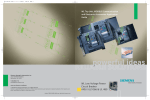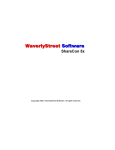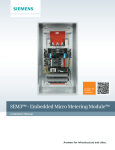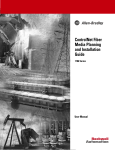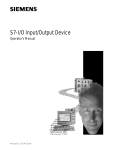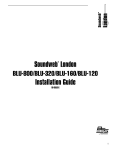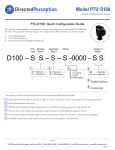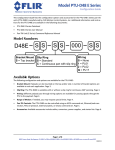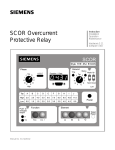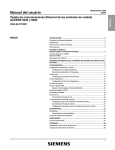Download SEM3™ – Embedded Micro Metering Module™
Transcript
Scan QR Code for more information SEM3™ – Embedded Micro Metering Module™ Quick Reference Guide Installation considerations Installation and maintenance of the SEM3 metering system should only be performed by qualified, competent personnel that have appropriate training and experience with high voltage and current devices. The meter must be installed in accordance with all local and national electrical codes. The SEM3 system is made up of the following components and options: 3.Meter racks – The meter modules are designed to snap into the rack assemblies. The rack assemblies are sized by how many modules will fit into each and come in 3, 9, 15 and 21 module configurations. 4.CT or current transformers – The SEM3 systems has solid core CTs for use with the system in the following maximum amperage ranges 50, 125, 250, 400, 600, 800 and 1200 amps. These are maximum amperage ranges for normal usage but will measure accurately down to 1% of the maximum range. 5.Communication cables – The communication cables are designed like CAT 5 cables but are insulated for use in systems up to 600 volts. The cables are for two way communication from the controller to the rack/meter modules. 1.Controller – The controller is used to communicate the metered values to outside systems by way of a web page interface, Modbus RTU or Modbus TCP. One controller can manage up to 45 meter modules.1) The controller also has the system digital inputs for receiving pulse inputs from other metering devices as well as a digital output for the combined KWh output of the system being metered. 2.Meter modules – There are two choices for the meter modules that are differentiated by accuracy specification. The accuracies are 1% for the standard accuracy modules and 0.2% for the high accuracy modules. The accuracy is tested in accordance to ANSI C12.20/0.2. Figure 1 SEM3 System Answers for infrastructure and cities. Configuring the system Ping statistics for 192.168.1.65: Packets: Sent = 4, Received = 4, Lost = 0 (0% loss), Approximate round trip times in milli-seconds: Minimum = 56ms, Maximum = 78ms, Average = 65ms There are a few steps in configuring the components of the SEM3 metering system. Refer to the Installation Manual instructions on mounting of the SEM3 components. Current Transformer (CT) – There is no setting on the CT for the system. The CTs for use in the SEM3 meter system are 100 mA output and are self protecting so shorting blocks are not required. Standard CT wire length is 6 feet. CT wire length can retain accuracy up to 100 feet using 18 AWG twisted pair wire. If not, then check your connection between the PC’s Ethernet port and the Controller MODBUS TCP/IP port. Solid core Open Explorer or Chrome and type out the IP address 192.168.1.65. Figure 2 Current transformer At the Login Page, the default user name is “admin”, and the default password is “sem3”. Meter modules – These instructions are for both levels of accuracy modules. Each meter module is a single phase meter and must be connected to the appropriately sized SEM3 system CT. The meter modules are then snapped into place into a rack assembly. The rack assembly has the module address to the controller hard coded in the hardware. Note: For metering of multi-pole circuit breakers, the meter modules must be mounted contiguously to each other. Power and communication indicator LED LED indicates Phase position switch location Release lever to allow easy removal from the rack Meter Racks – The meter module racks have the addresses for the module to controller communications hard coded into them. The 9, 15 and 21 module racks have a two position dip switch for setting one of two address ranges for each. The three module rack has a rotary switch to allow it to be configured for multiple address ranges. The chart below shows the ranges available for each rack. Figure 5 Four meter rack options with meters snapped inside Gaps in the rack will not allow multi-pole meters to be configured. Each module must have the phase dip switch on the top of the module set to the phase that the CT is metering; phase A, B, or C (Line 1, 2, or 3 respectively). Note: Once the meter module is placed into the rack and energized the phase position will be indicated by a different color LED for each position. These descriptions are for the connections to the controller not the LED colors on the meter module. (L1 phase A color is orange; L2 color is yellow; L3 color is green.) The LEDs are adjacent to the phase numbers. The power indication LED also indicates communications by flashing. CT sizing for each meter module will be done through the controller web page later in configuration. Controller – The controller functions as the set up interface for the system. System settings, CT ratios, PT ratios, alarm settings, communications settings and passwords are all set using the web page interface of the controller. See Installation Manual instructions for mounting and dimensional information. Blue mark indicates high accuracy, and burgundy mark indicates standard accuracy CT wire terminal blocks CT wire screw terminals Left (1) Three phase wiring QR code Isolated RS485C Ping your SEM3 Controller (Default IP address: 192.168.1.65) Open a Command Prompt and at the prompt type “ping” followed by a space & the IP Address of your SEM3 and press Enter. You should get the following: Pinging 192.168.1.65 with 32 bytes of data: 9, 15 and 21 Position Rack Dip Switch Setting Figure 3 Meter module To start – Connect the controller to a PC using the Ethernet / Modbus TCP port. See Figure 4. Assign Static IP address To change the PC / computer’s IP address in Windows 7 / 8, 1.Type network and sharing into the Search box in the Start Menu and select Network and Sharing Center when it comes up. 2.Then when the Network and Sharing Center opens, click on Change adapter settings. 3.Right-click on your local adapter and select Properties. 4.In the Local Area Connection Properties window highlight Internet Protocol Version 4 (TCP/IPv4) then click the Properties button. 5.Select the radio button and enter the correct IP address Ex. 192.168.1.100, and Subnet mask 255.255.0.0. The PC static IP address should be in the same IP address range of the SEM3 controller. 6.Close out of the Local Area Connections Properties window. 7.You can open the command prompt and do an ipconfig to see the network adapter settings have been successfully changed. Left chart indicates rack addresses for left setting on 9, 15 and 21 module racks and setting 0-7 on 3 module rack. Left rail MODBUS TCP/IP Two energy pulse in Right rail Energy pulse out Single Phase Monitor Modbus Addresses 1 1 1 2 2 2 3 3 3 3 4 4 4 4 5 5 5 5 6 6 6 6 7 7 7 7 8 8 8 8 9 9 9 9 10 10 10 11 11 11 12 12 12 13 13 13 14 14 14 15 15 15 16 16 17 17 18 18 19 19 20 20 21 21 23 25 26 27 (continued on next page) Open Address Space 21 Position Rack Modbus Addresses 15 Position Rack Modbus Addresses 9 Position Rack Modbus Addresses 1 33 33 33 33 0 2 34 34 34 34 3 1 35 35 36 36 37 37 37 37 38 38 38 38 39 39 39 39 40 40 40 40 41 9 41 41 41 10 42 42 42 43 43 43 44 44 44 Right (2) 13 45 45 45 14 46 46 46 15 47 47 47 48 48 17 49 49 18 50 50 19 5 35 36 5 11 3 35 36 6 7 Open Address space 24 Single Phase Monitor Modbus Addresses 3 Position Rack Modbus Addresses 2 Open Address Space 9, 15 and 21 Position Rack Dip Switch Setting 3 Position Rack Rotary Switch Setting 4 22 51 51 52 52 53 21 53 22 54 23 55 6 25 57 26 58 27 59 3 Position Rack Rotary Switch Setting 3 Position Rack Modbus Addresses 8 34 33 35 37 9 38 39 41 A 42 43 45 B 46 47 49 C 50 51 Open Address Space 53 D Open Address space 56 54 55 57 Open Address Space E 58 59 60 29 31 2 9 Position Rack Modbus Addresses 1 30 Reply from 192.168.1.65: bytes=32 time=56ms TTL=250 Reply from 192.168.1.65: bytes=32 time=60ms TTL=250 Reply from 192.168.1.65: bytes=32 time=69ms TTL=250 Reply from 192.168.1.65: bytes=32 time=78ms TTL=250 15 Position Rack Modbus Addresses 2 28 Figure 4 Controller 21 Position Rack Modbus Addresses Right chart indicates addresses for right setting on 9, 15, and 21 module racks and 8-F on 3 module rack. 7 29 61 30 62 31 63 61 F 62 63 32 The 3 module rack can be used as an extension to any of the other racks or pairs of racks. Settings must be such that no address is used more than once. Duplication of addresses will return an error on setup. 3 Login page – Default user name is “admin”, Default password is “sem3”. User name and password can be set to user preference and are case sensitive. See the User Manual for more detail. The web page has other settings available and can be accessed by clicking on the tabs at the top of the page. System settings – The following may be set from this page: (See user manual for more information) • IP configuration – For configuration of the IP address if using Modbus TCP. Be sure to write down the new IP address as you will lose communications once saved. • RTU slave configuration – For setting of address if used as a Modbus RTU device • Real time refresh interval – Time interval for the web page to refresh real time date • Device description – For naming of the system • Panel configurations to include: • Demand sub interval – Number of measurements taken in the sub interval • Sub interval length – Time between intervals • Voltage mode – Delta or Wye • Line to Neutral / Line to Line voltage depending on voltage mode • Potential Transformer (PT) Primary voltage – Secondary preset to 120 Save – Data changes must be saved before leaving this page or it will be lost. Reset Data available from this page – • Firmware version • Serial number of the controller Global settings – Global settings will be applied across all the meters in the system. Each meter can be customized in the Branch meter configuration screen. The alarms are for the meters and not meter modules. Individual phase alarms can only be set for single pole meters. Alarm delays are time settings where the meter is in alarm condition before the alarm flag is set. This is to prevent momentary conditions sending alarm flags. Siemens Industry, Inc. 5400 Triangle Parkway Norcross, GA 30092 1-800-241-4453 [email protected] Order No. RPFL-SEM3Q-0514 | Ref. No. 814388 Rev. 1P Printed in USA | © 2014, Siemens Industry, Inc. www.usa.siemens.com/SEM3 Multi-pole circuit breaker configuration – This page is used to configure the meter modules into meters. The bottom of the page displays those meters configured from the bottom of the page. The meter configuration is drag and drop from the available module column to the different meter configurations (1, 2 or 3 pole). Note that modules have to be mounted contiguously in the racks to be configured as multi-pole meters. Branch meter configuration – This page allows for customization of the configured meters. Custom alarms may be set that override the global alarms as well as naming of the individual meters. Real time data – This screen gives an overview of the alarm status of the configured meters and allows for clearing of the individual meter alarms. Clicking on the individual meters will display that meters real time information to the right of the grid. User profile – This page is accessible to all users who can modify their details except the ‘User ID’ and ‘Access Level’. User ID and Access Level are set by the Supervisor only from the User management screen. User management – This page is accessible to ‘Supervisor’ user who can manage users’ accounts that includes adding, removing and modifying the users. There are three levels of users available: • Supervisor – Has the ability to see all data and modify setting and clear alarms and add or modify user settings. • Controller – Has the ability to see all data and to clear alarms. Controller cannot see or modify user management. • Observer – Has the ability to see data but is not allowed to modify or clear alarms. Diagnostics – This page is accessible to ‘Supervisor’ user. The SEM3 metering system can work with supervisory systems such as WinPM.Net, Power manager and other SCADA or Building management systems that use Modbus protocol. The Modbus registers for this product are such that configuration using the controller web interface is not absolutely necessary, but by doing so valuable time can be saved. 1) Some applications will allow for more than 45 poles in one enclosure by adding a second controller. Two controllers can monitor up to 90 poles. The information provided in this brochure contains merely general descriptions or characteristics of performance which in case of actual use do not always apply as described or which may change as a result of further development of the products. An obligation to provide the respective characteristics shall only exist if expressly agreed in the terms of contract. All product designations may be trademarks or product names of Siemens AG or supplier companies whose use by third parties for their own purposes could violate the rights of the owners.



